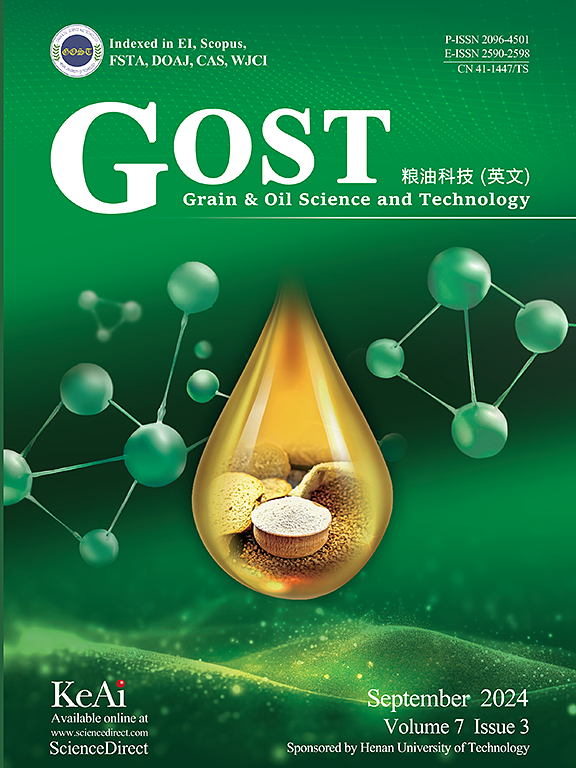Enzymatic modification of raw corn starch using thermostable glucoamylase from Thermothelomyces thermophilus
Q2 Agricultural and Biological Sciences
引用次数: 0
Abstract
Enzymatic modification is an important approach to changing the structure and expanding industrial application of natural starch. In the process of starch modification, thermostable enzymes are favored owing to their compatibility with higher reaction temperatures and lower required dosage. In this study, thermostable glucoamylase from Thermothelomyces thermophilus (TtGA) was heterologously expressed in Pichia pastoris, and its effects on the structure and physicochemical properties of raw corn starch were determined. The purified TtGA had a molecular weight of approximately 66 kDa, and its optimum reaction temperature and pH were 50 °C and 5.0, respectively. TtGA retained > 60% of its activity following treatment at 60 °C for 2 h and remained stable within a pH range of 4.0–7.0 for 6 h. The enzymatic modification of raw corn starch with TtGA led to 3% hydrolysis at 50 °C for 24 h. In comparison with natural raw corn starch, TtGA-modified starch had a smaller particle size with an unchanged crystalline structure, increased relative crystallinity, and amylose content. Scanning electronic observation showed that larger pores were formed on the surface of starch particles, and Fourier-transform infrared spectroscopy indicated that TtGA increased the degree of order in the raw corn starch. TtGA modification caused enhanced viscosity of the raw corn starch and altered the rheological properties with decreases in storage and loss moduli, as well as shear viscosity. Moreover, TtGA treatment enhanced the thermal characteristics of the raw corn starch, and decreased gelatinization enthalpy. This study provides detailed evidence for TtGA modification of raw corn starch, which would be helpful for its practical utilization in starch modification.

利用嗜热热酵母菌的耐热性葡萄糖淀粉酶对生玉米淀粉进行酶修饰
酶修饰是改变天然淀粉结构和扩大其工业应用的重要途径。在淀粉改性过程中,热稳定性酶因其具有较高的反应温度和较低的用量而受到青睐。在毕赤酵母中异源表达嗜热热热菌(Thermothelomyces thermophilus, TtGA)的耐热性葡萄糖淀粉酶,并研究其对玉米原料淀粉结构和理化性质的影响。纯化后的TtGA分子量约为66 kDa,最佳反应温度为50℃,pH为5.0。TtGA在60℃下处理2小时后,其活性保持在60%左右,并在pH值为4.0-7.0的范围内保持稳定6小时。用TtGA对玉米淀粉进行酶促改性,在50℃下处理24小时,其水解率为3%。与天然玉米淀粉相比,TtGA改性的淀粉粒径更小,晶体结构不变,相对结晶度和直链淀粉含量增加。扫描电子观察表明,淀粉颗粒表面形成了较大的孔隙;傅里叶变换红外光谱分析表明,TtGA提高了玉米淀粉的有序度。TtGA改性提高了玉米淀粉的粘度,改变了玉米淀粉的流变性能,降低了玉米淀粉的储存模量和损失模量,降低了玉米淀粉的剪切粘度。此外,TtGA处理提高了生玉米淀粉的热特性,降低了糊化焓。本研究为TtGA改性玉米淀粉提供了详实的依据,有助于TtGA在淀粉改性中的实际应用。
本文章由计算机程序翻译,如有差异,请以英文原文为准。
求助全文
约1分钟内获得全文
求助全文
来源期刊

Grain Oil Science and Technology
Food Science
CiteScore
7.30
自引率
0.00%
发文量
69
审稿时长
12 weeks
期刊介绍:
 求助内容:
求助内容: 应助结果提醒方式:
应助结果提醒方式:


